Colouring Our Shores and Streets
From shore to street, Singapore is awashed in colour thanks to the lovely hues of leaves and flowers of the trees around us. Colours like red, orange, pink and yellow amidst our greenery keep shutterbugs busy and remind us all why we love the trees in our City in Nature.
Take a walk outside and enjoy these colourful trees.
Golden Shower Tree

Photo credit: Zaki Jamil
A fast-grower, the Golden Shower (Cassia fistula) is medium-sized tree that can reach up to 18 m in height. Deciduous, it sheds its leaves every eight to 10 months, especially when flowering.
It produces bright yellow, fragrant flowers in long pendulous clusters, some reaching up to 50 cm in length. These attract butterflies like the Orange Emigrant (Catopsilia scylla cornelia) and Mottled Emigrant (Catopsilia pyranthe pyranthe). Its fruits are long cylindrical pods of about 40 cm to 60 cm in length and become black when matured. Its seeds are covered with a blackish-brown, pungent-smelling sticky sweet pulp.
It is believed that nearly all parts of the plant have medicinal properties and can be used to treat ailments ranging from pimples, burns, wounds and colds to cancer! For example, the seed pods and leaves are used to treat diabetes and liver problems while pulp from the seed pod has mild laxative properties and can be used to relieve constipation.
Sea Almond
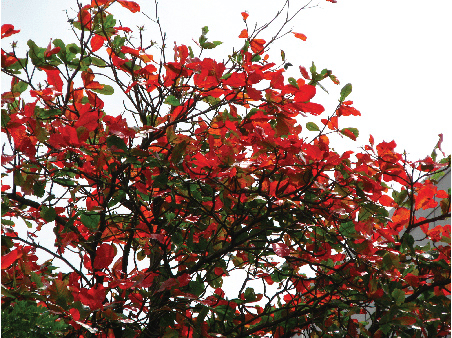
The Sea Almond (Terminalia catappa), also known as Ketapang, is a pagoda-shaped tree that can grow up to 35 m. Its trunk is often buttressed, with grey bark that is slightly fissured.
It has spiral, stalked leaves that are papery to thinly leathery. They are dark green above, yellowish green below and will turn a striking red before falling. Each leaf is reserve-egg-shaped, measuring from 8 cm to 36 cm in length and about 5 cm to 19 cm wide. The tree shed its leaves twice a year. Due to its colourful foliage, it is a common roadside tree that can tolerates hot sun, dry and high wind conditions.
It produces white to whitish green small fragrant flowers and fruits that have a stony core. The fruits are flattened-egg-shaped and green when unripe, turning yellow or red when ripe. The fruits attract bats which help with seed disposal.
Golden Penda
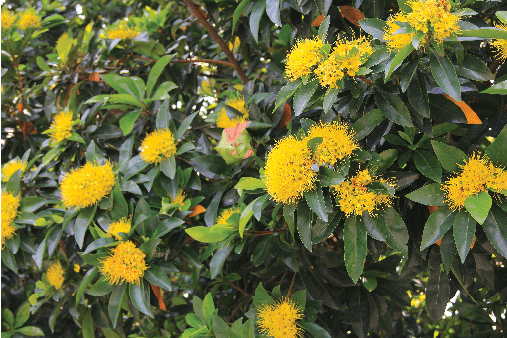
Photo credit: Shi Biying
A tropical tree than can grow to 8 m to 12 m in height under cultivation, but up to 40 m in its native environment, the Golden Penda (Xanthostemon chrysanthus) produces lance-shaped leaves that are dark green and leathery to the touch.
Its flowers are bright yellow with five petals attached to the rim of the calyx. Its yellow stamens are around 3 cm in length. These pretty flowers make this a common roadside tree where they also attract birds, butterflies and bees that help pollinate the plant. Flowering is believed to be induced by sudden drops in temperatures.
Its fruits are capsules, turning from green to brown upon maturation. Its seeds are dispersed by explosive action.
Trumpet Tree
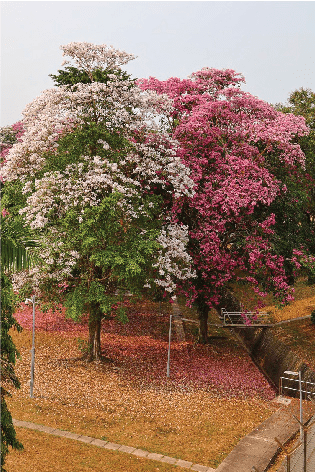
The large pink or white trumpet-shaped flowers have five petals each and measure between 5 cm to 8 cm long. Flowering is typically triggered by heavy rains after a long, hot and dry spell, usually between March and April, and again between August and September. These blooms last for several days before wilting.
Its bark is reported to have anti-oxidant properties and the timber is used for construction and to make furniture.
Nyireh Batu

Photo credit: Pauline Tay
Occurring in tidal forests, banks of tidal creeks or along our open shores, the Nyireh Batu (Xylocarpus moluccensis) is a medium to large-sized tree that can grow up to 30 m in height. Its trunk diameter can measure up to 2 m and is deeply fissured.
Native to Singapore, it displays beautiful orangey-yellow foliage. Its leaves are spirally arranged, usually in two to three leaflets. It produces broadly ellipsoid greenish-brown fruit that measures 8 cm to 11 cm in diameter. Each fruit has about five to 10 brown seeds. These seeds are said to be used as medicine for stomach aches. Its timber is also used to construct houses, boats and also as firewood.
Handkerchief Tree
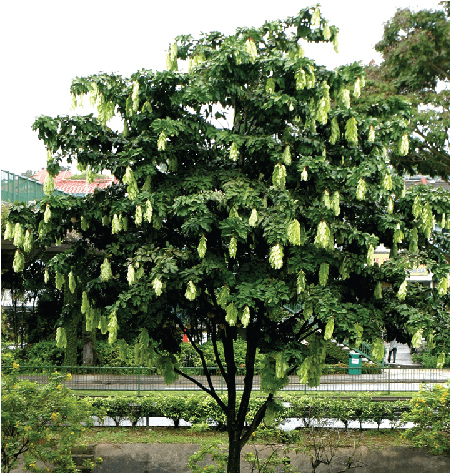
Photo credit: Lee Shiyun
A small to medium-sized tree that can grow up to 12 m tall, the Handkerchief Tree (Maniltoa browneoides) produces young leaves that hang vertically downwards from the branches. They appear white to whitish green, taking a few days to turn darker and becoming erect. The young leaves resemble soft white handkerchiefs, hence its common name.
These very prominent young flushes lead this tree to be planted along our streets for aesthetic purposes. The tree also produces white flowers that are borne in large, rounded terminal clusters surrounded by brown, papery bracts. The flowers appear together with the new flushes, turning rapidly from white to brown once pollinated or damaged. They also attract birds such as starlings and sunbirds.
Our City in Nature
Over the years, NParks has created a green network comprising roadside planting and a Park Connector Network that links up parks and other green spaces. Skyrise greenery dot developments while biophilic design has been adopted in restoring habitats.
But as Singapore continues to urbanise, the growing infrastructure will put increasing pressure on the established green cover. Coupled with climate change and more extreme weather conditions, this will result in higher urban temperatures and the increased risks of localised flooding events. Our City in Nature vision works to ensure the city develops in a way that continues to provide a high-quality living environment for residents while ensuring Singapore remains a distinctive global city.
Learn more about City in Nature here.
Learning More
If you are heading to our green spaces, do the right thing and be socially responsible. Keep to not more than five persons in a group. Always wear a mask except when you are engaged in strenuous exercise or when consuming food, drink or medication.
Before heading down to our parks, please visit SafeDistParks.nparks.gov.sg for the latest updates on visitorship levels.
Visit NParksSG, our refreshed YouTube Channel that serves as a one-stop repository for close to 300 video resources. It also provides you a platform for existing and future digital outreach including DIY gardening and related crafts, virtual tours of our green spaces, and livestream events.
Interested to learn about the flora and fauna found in Singapore? Visit NParks Flora & Fauna Web here.
If you like what you read, follow us on Facebook, Instagram and Telegram to get the latest updates.
Text compiled by Felix Siew



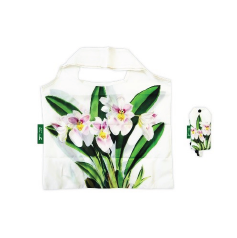
Have views or comments on this article? Let us know via this form. If you would like to give us feedback on any other areas relating to our parks and gardens, please submit via https://www.nparks.gov.sg/feedback